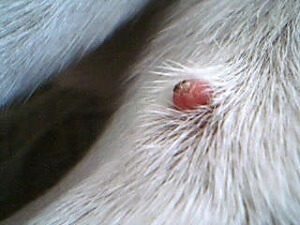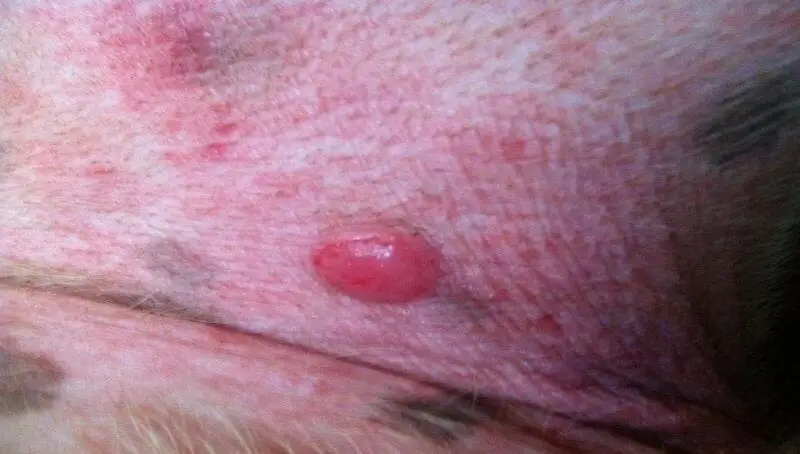If you’ve ever noticed some strange black blisters on the abdomen of your dog, then you might have been pretty concerned. These types of black spots are known to vets as blood blisters. Although this black spot might look cancerous and will usually get most people alarmed, is it really a reason to stress over? Let’s find out what causes blood blisters on a dog’s belly.
What Exactly Are Blood Blisters on a Pet’s Belly?
The medical term for a blood blister on the belly is hematoma. This solid swelling is caused by the clotting of the blood in a certain area. It is basically the same as a pustule, but instead of being filled with pus, it has blood content. Most of the time it won’t show up only in the midsection of the dog’s body. It is actually more common on other parts of the dog’s body, like his ears.
You might also like my articles on what to do if your dog is stung by a bee, has diarrhea, or suffers from Cushing’s disease.
When located on the skin, it is actually easier to spot, because it is discolored and swells quite a bit. It can also become more visible if the dog starts to scratch it excessively, due to it being itchy. At the same time, if the blister is painful, the dog might show a sign of aversion to the touch around the area.
What is the Cause of Blood Blisters on Dogs?
Hematomas will usually show on a dog’s body due to blunt trauma or injury. When located around the ears, this type of hematoma will usually be caused either by too much scratching or by too much shaking of the head. A blood blister on the belly will basically be caused by a similar factor – either too much nibbling or intense scratching in the area.
A trauma of medium intensity might have caused a blood vessel to pop and the blood has nowhere to go due to the skin not piercing. What it does instead is get clogged and form a pocket right beneath the skin. Some skin conditions and even allergies can also cause these types of blisters.
Should You Go To The Vet When Noticing a Blood Blister?
 Noticing a blood blister isn’t enough to know if it’s time to go to the vet or not. The signs given by your dog are also important when making this decision. Most of the time, a simple blood blister on the dog’s belly will be harmless and shouldn’t warrant a visit to the veterinarian. A simple blood blister that isn’t causing any pain should go away by itself after 48 hours or so. So, if you can’t see signs of your dog being in pain or discomfort, like whelping or whimpering, then just keep him under observation and see if everything is better after a day or two.
Noticing a blood blister isn’t enough to know if it’s time to go to the vet or not. The signs given by your dog are also important when making this decision. Most of the time, a simple blood blister on the dog’s belly will be harmless and shouldn’t warrant a visit to the veterinarian. A simple blood blister that isn’t causing any pain should go away by itself after 48 hours or so. So, if you can’t see signs of your dog being in pain or discomfort, like whelping or whimpering, then just keep him under observation and see if everything is better after a day or two.
On the other hand, if things are on the opposite side and the dog is clearly restless or erratic in his behavior, then you might have to take him to the vet to have the blood blister checked out. Even if it turns out that the blister wasn’t something to worry about, the vet will at least give you guidance on what you should do.
Treatments for a Blood Blister?
Don’t lose any time figuring out the best treatment if your dog has a blood blister that doesn’t go away on its own in a few days. go to the vet instead as soon as possible for possible treatment. Depending on the exact location of the blister and its actual size, the vet might be able to drain it on the spot. Even though draining might fix the problem in the short term, the pocket might start to fill up with blood again after a short while. Depending on how severe the blister actually is, after draining it, the vet might also attach a temporary drain so that the blood can get cleared before it fills up the blister again. Surgery might also be needed in some cases where the blister is far from the skin or in more sensitive areas.
Keep in mind that a blood blister is an effect of another underlying cause, so you should address the root of the problem as well if you don’t want the blister to resurface. Depending on what the vet finds out, they might prescribe medication against skin conditions or parasites, to stop the dog from creating additional traumas due to excessive scratching.
If the blisters are situated around the ear area, then your vet could either have your pet wear a dog cone or bandage his ears to prevent him from scratching too much. Try your best not to let your dog scratch when you get home and give him the medication he needs. Bathing the pet periodically will also help, as well as cleaning his ears.




